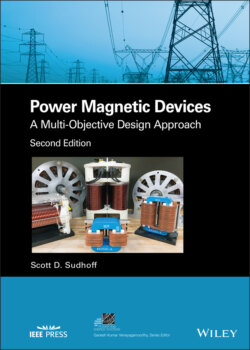Читать книгу Power Magnetic Devices - Scott D. Sudhoff - Страница 15
1.1 Design Approach
ОглавлениеIt is appropriate to begin this work by considering the design process. Clearly, there are a myriad of different approaches by which components may be designed. For example, a possible manual design process is illustrated in Figure 1.1. In order to consider this process in a more concrete way, suppose that the component we are designing is an electromagnet and that we wish to design an electromagnet so that a certain set of specifications are met.
Using the design process in Figure 1.1, our first step would be to perform a detailed mathematical analysis of the device. Typically, when we analyze a device, our analysis predicts device performance (mass, loss, force) in terms of the device parameters (geometry, materials) rather than directly addressing the design problem by deriving expressions for what the device parameters should be in terms of the device specifications (allowed loss, required force). Therefore, we must manipulate our detailed analysis into a set of design equations that are used to calculate the design parameters as a function of device specifications. However, going from detailed analysis to design equations invariably requires numerous assumptions and approximations, even beyond the ones found in our original “detailed” analysis. As a result, we check our design, either against our original analysis or using some numerical tool such as a finite element analysis. Based on the results from the numerical analysis, we will revise the design and repeat the numerical analysis until specifications are met, at which point we have arrived at a final design. Of course, we often use a more involved design process; for example, another iteration of the design may be made based on physical prototypes.
The manual design process we have been considering involves an engineer in the iteration process. Variations of this process are successfully used ubiquitously throughout the engineering community. However, the process has some significant drawbacks. First, it requires a great deal of engineering time. Second, it requires a great deal of engineering experience. This experience comes into play in the development of the design equations, which often take the form of rules‐of‐thumb based at least partially on experience. Experience is also a factor in making changes to the design based on the numerical analysis. Finally, while the process has been very successful in yielding working designs, it may not lead to the best design.
Figure 1.1 A manual design process.
Figure 1.2 Optimization‐based design process.
An alternate design process is illustrated in Figure 1.2. Therein, an optimization‐based design process is shown. In this case, the process is not illustrated in a sequential manner as in Figure 1.1, but rather in an organizational manner. The process again starts with a detailed analysis of the device or component. However, unlike the manual design process, in the optimization‐based process, the detailed analysis is not used to formulate design equations. Instead, the detailed analysis is used to calculate design metrics such as mass, cost, and loss. The detailed analysis is also used to check constraints such as achieving some minimum acceptable level of performance. The metrics and constraints are combined into an objective or fitness function. This function is defined so that its optimization results in optimization of the design metrics subject to all design constraints being met.
At the outermost level of this design process, an optimization engine will select the parameters of the design (geometry, materials, etc.) so as to maximize the objective function. In terms of computational algorithm, Figure 1.2 depicts an optimization engine at the outer level. This engine operates on an objective function that is calculated based on the detailed analysis.
There are several advantages of this approach. First, it is unnecessary to formulate design equations. This is beneficial in that it reduces the number of approximations and assumptions made and reduces the amount of design experience needed for a good design. Second, the design is formally optimized with regard to the design metrics, potentially leading to better designs, at least in terms of the design metrics. Third, since the engineer is out of the optimization loop, less engineering time is generally required. There are some disadvantages of the procedure. First, the process can be numerically intense and require significant computing time, sometimes on the order of hours and, in extreme cases, days. Fortunately, computer time is significantly less expensive than engineering time. Second, the quality of the result depends upon the quality of the detailed analysis. In this regard, design experience is still valuable, though not as critical as in the manual design approach.
In order to utilize the optimization‐based design process, it is clearly necessary to be able to optimize mathematical functions. For design purposes, we will be optimizing the objective function, which we will also refer to as a fitness function. Optimization is a broad subject, which has been the subject of a strong and sustained interest of a host of researchers over the years. The purpose of this chapter is to introduce the subject to an extent sufficient to enable the reader to utilize an optimization‐based design process for power magnetic devices. More thorough study of optimization methods will serve every engineer well; for a good textbook devoted to the subject the reader is referred to Chong and Żak [1].
